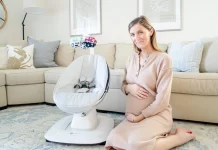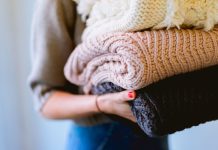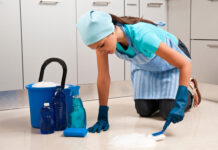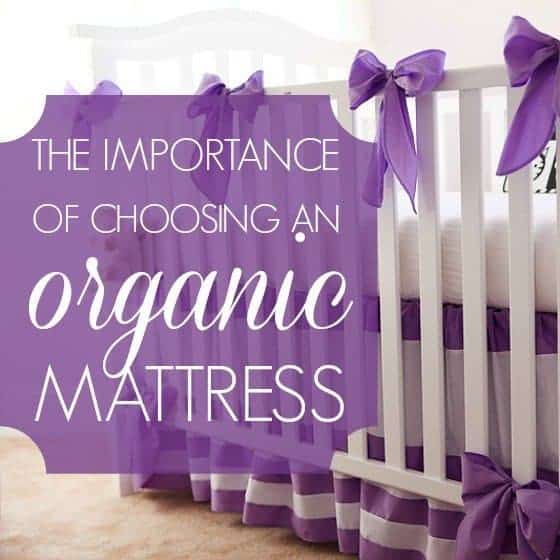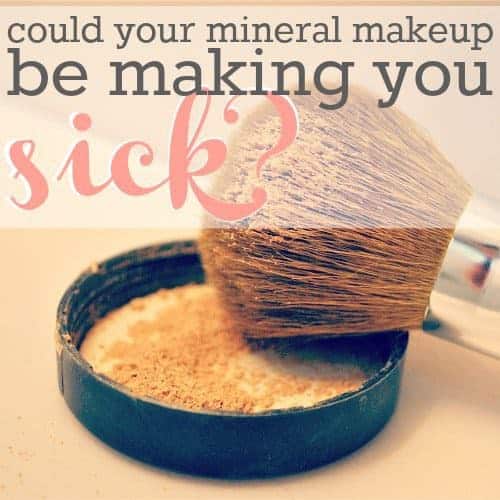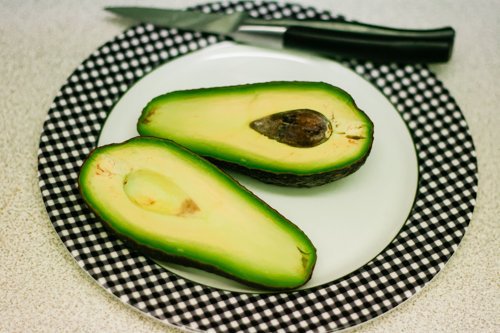A baby can spend anywhere from 12-16 hours per day sleeping, sometimes even more. Because a baby spends so much of his time asleep and because a baby’s lungs are still developing in infancy, it’s important to create a safe environment for sleep and rest. A mattress can be a big investment, but investing in a quality, organic mattress is one of the best investments for your child.
What’s In A Mattress?
- Mattresses, including crib mattresses, are by law required to be flame retardant. This can be achieved in several ways, such as with natural fibers like wool. Unfortunately the cheapest way is by treating the mattress with synthetic chemicals that may be toxic or carcinogenic.
- Antimony, a metalloid element, is commonly found in fire retardants. Relatively little is known about this element’s toxicity but epidemiological studies suggest carcinogenic effects on the lungs via inhalation of some of it’s common compounds (1) and it has also been linked to heart and eye problems (2). Another compound used as a flame retardant is boric acid, which is also used as a insect poison. The EPA has placed boric acid and it’s derivatives into Toxic Category III for acute oral and dermal toxicity as well as eye irritation (3). Animal studies on its safety have found reproductive and developmental toxicity (3).
- Polyurethane is the foam filling used in most mattresses. Polyurethane can emit toxins such as VOCs (volatile organic compounds) or formaldehyde, which can cause skin and respiratory irritation. Polyurethane is highly flammable, and thus requires a great deal of fire retardants to make it safe. Aside from potential toxins, polyurethane foam absorbs and stores body heat and overtime can lose it’s elasticity, both which can create unsafe sleeping conditions for a baby.
- Waterproof mattress covers often contain PVC, made from vinyl chloride. The EPA has classified vinyl chloride as a Group A human carcinogen. Inhalation can include acute effects on the nervous system, such as dizziness and headaches. Chronic effects include damage to the liver and kidneys (4). PVC is not itself very flexible, so phthalates may be added to make the cover material more flexible. Further, phthalates are not chemically bound to PVC and therefore are easily released into the environment. Among other health affects, phthalates are widely considered to be endocrine disrupters and carcinogens. Other compounds in mattress covers can be toxic as well. A 1999 study on mice found a variety of acute toxic effects including asthma-like symptoms after exposure to waterproof crib mattresses and concluded that off-gassing of toxic chemicals may contribute to the rise in the prevalence of childhood asthma (5).
- Cotton and wool are two great alternatives to PVC for mattress filling. However, toxic chemicals can still find their way into the manufacturing process. The cotton crop may be heavily sprayed with pesticides and fungicides, for example.
Toxic Gas Theory of SIDS
One theory on Sudden Infant Death Syndrome (SIDS) concerns chemicals commonly used in the manufacturing of mattresses. Mattresses, as well as sheepskins, can contain the elements phosphorus, arsenic, and antimony. These occur naturally in sheepskins, while phosphorous may be present in mattress covers and arsenic and antimony added as flame retardants. These three chemicals are consumed by the fungus S. brevicaulis. The theory goes that this fungus is established in a mattress from sweat, spit up, and so on, which then consumes these chemicals. The fungus then releases three nerve gases (phosphine, arsine, and stibine) which can be toxic.
A New Zealand study and subsequent program launched advocated wrapping mattresses in covers that would not allow such nerve gases to permeate the covers and reach the baby. While this theory has not been completely proven, nor disproven, it can explain a number of observations about the pattern of crib death. For example, putting babies on their back to sleep has reduced the incidence of SIDS and may be because babies are not inhaling as much of the nerve gas released by the fungus. The New Zealand study has promoted mattress wrapping and has a reported success rate of 100% (6). That is, there have been no SIDS deaths in the purported 170,000 instances of mattress wrapping using the recommended polyethylene cover (6). Another observation that this theory explains is that the risk of SIDS appears higher in babies reusing a sibling’s old mattress. According to this theory the explanation for this would be that the fungus has become previously established in the mattress from the first baby to use it. Learn more about choosing a good crib mattress according to matter mattress.
It is important to note that the three elements consumed by the fungus–phosphorus, arsenic, and antimony–are said to be naturally occurring in materials used for bedding such as (some) sheepskin, wool, sheep fleece, and horsehair (7). If this is true and the theory is correct then that means it is not enough to buy an organic mattress (free of as many added chemicals as possible) but to use covers that are impermeable to the nerve gases generated.
Advantages of a Natural and Organic Mattresses
The most obvious advantage to buying a mattress that is organic and made of natural components is that it is free of harsh, toxic chemicals. But natural materials also boast some advantages on their own as well.
 Wool is often a component of great mattresses, both for temperature and moisture regulation, as well as fire retardancy. Image from Naturalmat USA organic mattresses.
Wool is often a component of great mattresses, both for temperature and moisture regulation, as well as fire retardancy. Image from Naturalmat USA organic mattresses.
Temperature & Moisture Regulation: Natural fibers help regulate temperature and moisture. Wool, for example, is considered to be a great regulator of both. It can help keep a person cool or warm as it whisks away moisture to keep skin dry and also acts as an insulator. Compared to adults, babies are poor regulators of their temperature and can benefit from mattress materials that help them maintain a comfortable body temperature. Organic cotton is also very breathable and not flammable like PVC is. Coir fiber, found in mattresses such as those by Naturalmat, is also very breathable as well as naturally springy.
Durability: Natural components such as latex rubber foam are dense enough to create a firm mattress without the use of innersprings and keeps it shape very well. It is also anti-microbial and resistant to dust mites. Some sources claim natural latex is hypo-allergenic, while others say allergies to true latex do exist (but are very uncommon). Horsetail hair and coir fiber also provide natural but long-last spring to a mattress.
Flammability: Wool is naturally fire-resistant and therefore can be used to meet flammability standards without the addition of the toxic additives described above.
![]()
What to Look For
-
-
- Check the label for components of the mattress. But don’t stop there: be sure to investigate further to find out how the mattress may have been treated. Some components or treatments may be propriety and not disclosed by the manufacturer. If they don’t disclose this voluntarily or upon request, look for other products.
- Read beyond “greenwashing” and liberal use of the words “natural”, “green”, “eco-friendly”, and “non-toxic”.
- Look for certification by third parties, which are usually non-profit and/or government organizations with no financial interest. Third-party certifications for crib mattresses include, for example, GREENGUARD, Oeko-Tex, and GOTS.
-
-
-
-
- Be aware that products can be marketed to be organic just by virtue of containing organic materials. However, the final product may still contain toxic chemicals added during the manufacturing. The GOTS certification covers both the components and production.
- Pay special attention to the waterproof cover and determine what is used to make it so. Safer waterproofers include certified organic wool and low-density polyethylene. While petroleum-based, polyethylene is lightweight and low-toxicity (if not contaminated by additives). Food-grade polyethylene is what is used in the mattress-wrapping campaign advocated by the New Zealand study.
-
-
![]()
Researching baby products, especially mattresses, and sorting through manufacturer information can be time-consuming and frustrating. But given that a baby spends so much time sleeping, researching and investigating a mattress that’s right for your baby and family’s needs is definitely worthwhile.
References
1. Beyersmann D. & Hartwig A. (2008) Carcinogenic metal compounds: recent insight into molecular and cellular mechanisms. Archives of Toxicology, 82(8):493-512. doi: 10.1007/s00204-008-0313-y.
2. Clean and Healthy New York, American Sustainable Business Council (November 2011). The Mattress Matters: Protecting Babies from Toxic Chemicals While They Sleep. https://www.cleanhealthyny.org/MattressMattersReport-Jan2012.pdf A great report on crib mattresses with analysis and information from 28 manufacturers.
3. United States Environmental Protection Agency (September 1993). Prevention, Pesticides, And Toxic Substances, “Boric Acid: Reregistration Eligibility Decision (R.E.D.) Factsheet”. https://www.epa.gov/oppsrrd1/REDs/factsheets/0024fact.pdf
4. United States Environmental Protection Agency (January 2000). Vinyl Chloride Hazard Summary. https://www.epa.gov/ttnatw01/hlthef/vinylchl.html
5. Anderson R.C. & Anderson J.H. (1999) Respiratory toxicity in mice exposed to mattress covers. Archives of Environmental Health: An International Journal, 54(3):202-209. doi: 10.1080/00039899909602260
6. Sheppard J. Toxic Gases in Baby Crib Mattresses. https://www.healthychild.com/has-the-cause-of-crib-death-sids-been-found/
7. TheCauseOfSIDS.org. https://www.thecauseofsids.org/first.htm
Title image from The Art of Making A Baby; Image of mattress courtesy of John Kasawa / FreeDigitalPhotos.net
